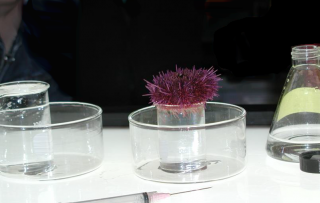

Whole Effluent Toxicity (WET) refers to the aggregate toxic effect to aquatic organisms from all pollutants contained in a facility's wastewater (effluent). It is one way we implement the Clean Water Act's prohibition of the discharge of toxic pollutants in toxic amounts. WET tests measure wastewater's effects on specific test organisms' ability to survive, grow and reproduce.
The WET methods listed below are specified at 40 CFR 136.3, Table I A. WET test methods consist of exposing living aquatic organisms (plants, vertebrates and invertebrates) to various concentrations of a sample of wastewater, usually from a facility's effluent stream. WET tests are used by the National Pollutant Discharge Elimination System (NPDES) permitting authority to determine whether a facility's permit and discharge complies with the WET requirements or limits.
All three manuals include guidelines on laboratory safety, quality assurance, facilities and equipment, organism culturing and handling, dilution water, effluent sampling and sample handling, test procedures, test endpoints and data analysis, and report preparation.
The tests in the WET Acute Methods Manual (5th edition, 2002) consist of a control and a minimum of five effluent concentrations. The EPA recommends the use of ≥0.5 dilution factor and five effluent concentrations and a control. The test duration is typically 24, 48, or 96 hours. The test methods allow for permutations such as temperature, dilution water, frequency of the effluent renewal and more. The following methods listed in 40 CFR 136.3 are described in the manual.
The tests in the WET Freshwater Chronic Methods Manual (4th edition, 2002) recommend the use of the ≥0.5 dilution factor and five effluent concentrations and a control for four to eight days. The test methods allow for permutations such as various dilution waters, daily or three effluent sample collections for daily test renewals, and more. The biological test endpoints include survival, growth, reproduction, or teratogenicity.
The tests in the WET Marine Chronic Methods Manual (3rd edition, 2002) typically involve the exposure of test organisms to five effluent concentrations and a control for one hour to nine days. The test methods allow for permutations such as various dilution waters, daily or three effluent sample collections for daily test renewals, and more. In addition to survival, sub-lethal endpoints such as growth, fecundity, teratogenicity, or fertilization are measured. These methods listed in 40 CFR Part 136.3 apply to marine and estuarine organisms of the Atlantic Ocean and the Gulf of Mexico.
Note: While there are additional test procedures in the marine and estuarine test method manuals, two are not listed in 40 CFR 136.3, Table I A: